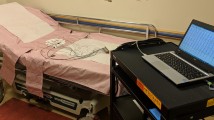Abstract
Cardiac rhythm is an essential component of fetal cardiac evaluation. The Monica AN24 is a fetal heart rate monitor that may provide a quick, inexpensive modality for obtaining a noninvasive fetal electrocardiogram (fECG) in a clinical setting. The fECG device has the ability to acquire fECG signals and allow calculation of fetal cardiac time intervals between 16- and 42-week gestational age (GA). We aimed to demonstrate the feasibility of fECG acquisition in a busy fetal cardiology clinic using the Monica fetal heart rate monitor. This is a prospective observational pilot study of fECG acquired from fetuses referred for fetal echocardiography. Recordings were performed for 5–15 min. Maternal signals were attenuated and fECG averaged. fECG and fetal cardiac time intervals (PR, QRS, RR, and QT) were evaluated by two cardiologists independently and inter-observer reliability was assessed using intraclass coefficient (ICC). Sixty fECGs were collected from 50 mothers (mean GA 28.1 ± 6.1). Adequate signal-averaged waveforms were obtained in 20 studies with 259 cardiac cycles. Waveforms could not be obtained between 26 and 30 weeks. Fetal cardiac time intervals were measured and were reproducible for PR (ICC = 0.89; CI 0.77–0.94), QRS (ICC = 0.79; CI 0.51–0.91), and RR (ICC = 0.77; CI 0.53–0.88). QT ICC was poor due to suboptimal T-wave tracings. Acquisition of fECG and measurement of fetal cardiac time intervals is feasible in a clinical setting between 19- and 42-week GA, though tracings are difficult to obtain, especially between 26 and 30 weeks. There was high reliability in fetal cardiac time intervals measurements, except for QT. The device may be useful for assessing atrioventricular/intraventricular conduction in fetuses from 20 to 26 and >30 weeks. Techniques to improve signal acquisition, namely T-wave amplification, are ongoing.





Similar content being viewed by others
References
Amer-Wahlin I, Arulkumaran S, Hagberg H, Marsal K, Visser GH (2007) Fetal electrocardiogram: ST waveform analysis in intrapartum surveillance. BJOG 114(10):1191–1193
Bergveld P, Kolling AJ, Peuscher JH (1986) Real-time fetal ECG recording. IEEE Trans Biomed Eng 33(5):505–509
Clifford G, Sameni R, Ward J, Robinson J, Wolfberg AJ (2011) Clinically accurate fetal ECG parameters acquired from maternal abdominal sensors. Am J Obstet Gynecol 205(1):471–475
Gardiner HM, Belmar C, Pasquini L, Seale A, Thomas M, Dennes W et al (2007) Fetal ECG: a novel predictor of atrioventricular block in anti-Ro positive pregnancies. Heart 93(11):1454–1460
Govindan RB, Vairavan S, Sriram B, Wilson JD, Preissl H, Eswaran H (2011) Phase plane based identification of fetal heart rate patterns. Conf Proc IEEE Eng Med Biol Soc 2011:1455–1458
Graatsma EM, Jacod BC, van Egmond LA, Mulder EJ, Visser GH (2009) Fetal electrocardiography feasibility of long-term fetal heart rate recordings. BJOG11 6(2):334–337
Gritzali F, Frangakis G, Papakonstantinou G (1989) Detection of the P and T-waves in an ECG. Comput Biomed Res 22(1):83–91
Hasan MA, Reaz MB, Ibrahimy MI, Hussain MS, Uddin J (2009) Detection and processing techniques of FECG signal for fetal monitoring. Biol Proced Online. 11:263–295
Hayashi R, Nakai K, Fukushima A, Itoh M, Sugiyama T (2009) Development and significance of a fetal electrocardiogram recorded by signal-averaged high-amplification electrocardiography. Int Heart J 50(2):161–171
Horigome H, Takahashi MI, Asaka M, Shigemitsu S, Kandori A, Tsukada K (2000) Magnetocardiographic determination of the developmental changes in PQ, QRS and QT intervals in the foetus. Acta Paediatr 89(1):64–67
Leuthold A, Wakai RT, Martin CB (1999) Noninvasive in utero assessment of PR and QRS intervals from the fetal magnetocardiogram. Early Hum Dev 54(3):235–243
Luo S, Michler K, Johnston P, Macfarlane PW (2004) A comparison of commonly used QT correction formulae: the effect of heart rate on the QTc of normal ECGs. J Electrocardiol 37(Suppl):81–90
Oostendorp TF, van Oosterom A, Jongsma HW (1989) The effect of changes in the conductive medium on the fetal ECG throughout gestation. Clin Phys Physiol Meas 10(Suppl B):11–20
Quinn A, Weir A, Shahani U, Bain R, Maas P, Donaldson G (1994) Antenatal fetal magnetocardiography: A new method for fetal surveillance? Br J Obstet Gynaecol 101(10):866–870
Reinhard J, Hayes-Gill BR, Yi Q, Hatzmann H, Schiermeier S (2010) Comparison of non-invasive fetal electrocardiogram to Doppler cardiotocogram during the 1st stage of labor. J Perinat Med 38(2):179–185
Rychik J, Ayres N, Cuneo B, Gotteiner N, Hornberger L, Spevak PJ et al (2004) American Society of Echocardiography guidelines and standards for performance of the fetal echocardiogram. J Am Soc Echocardiogr 17(7):803–810
Stinstra J, Golbach E, van Leeuwen P, Lange S, Menendez T, Moshage W et al (2002) Multicentre study of fetal cardiac time intervals using magnetocardiography. BJOG 109(11):1235–1243
Strasburger JF, Cheulkar B, Wakai RT (2008) Magnetocardiography for fetal arrhythmias. Heart Rhythm 5(7):1073–1076
Symonds EMSD, Chang A (2001) Historical development. In: Symonds EMSD, Chang A (eds) Fetal electrocardiography. Imperial College Press, London, pp 1–29
Taylor MJ, Smith MJ, Thomas M, Green AR, Cheng F, Oseku-Afful S et al (2003) Non-invasive fetal electrocardiography in singleton and multiple pregnancies. BJOG 110(7):668–678
Velayo C, Sato N, Ito T, Chisaka H, Yaegashi N, Okamura K et al (2011) Understanding congenital heart defects through abdominal fetal electrocardiography: case reports and clinical implications. J Obstet Gynaecol Res. 37(5):428–435
Conflict of interest
The authors declare they have no conflict of interest.
Ethical standard
All procedures performed in the studies involving human participants were in accordance with the ethical standards of the institutional and/or national research committee and with the 1964 Helsinki Declaration and its later amendments or comparable ethical standards. This article does not contain any studies with animals performed by any of the authors.
Informed consent
Informed consent was obtained from all individual participants included in the study.
Author information
Authors and Affiliations
Corresponding author
Rights and permissions
About this article
Cite this article
Arya, B., Govindan, R., Krishnan, A. et al. Feasibility of Noninvasive Fetal Electrocardiographic Monitoring in a Clinical Setting. Pediatr Cardiol 36, 1042–1049 (2015). https://doi.org/10.1007/s00246-015-1118-4
Received:
Accepted:
Published:
Issue Date:
DOI: https://doi.org/10.1007/s00246-015-1118-4




